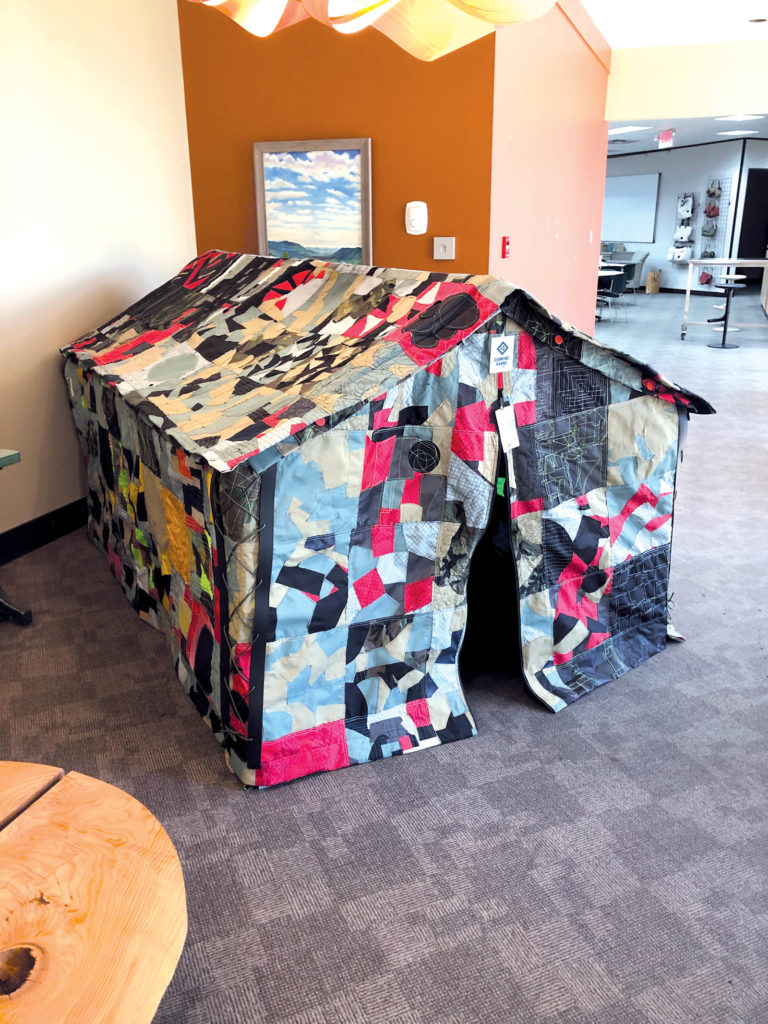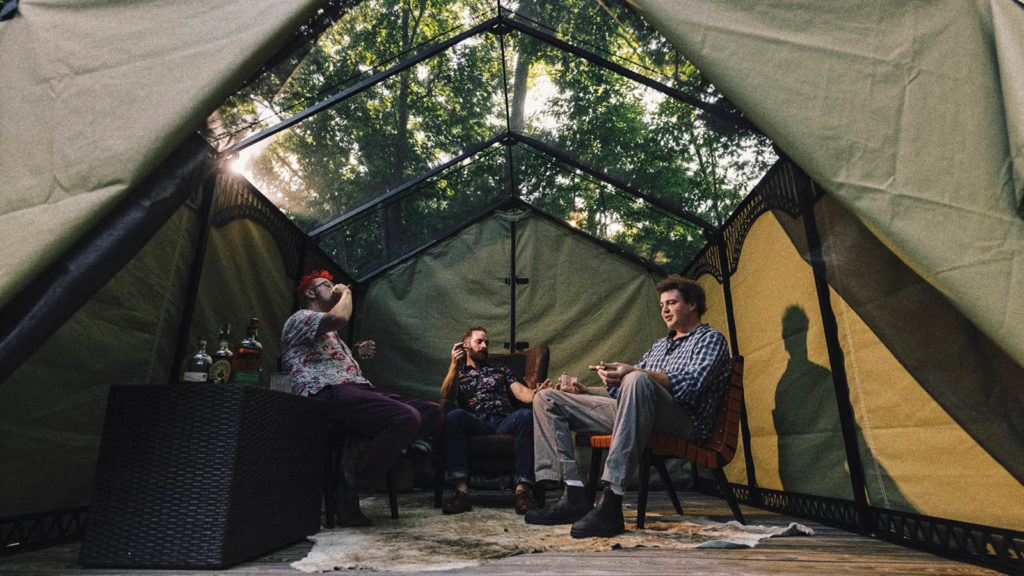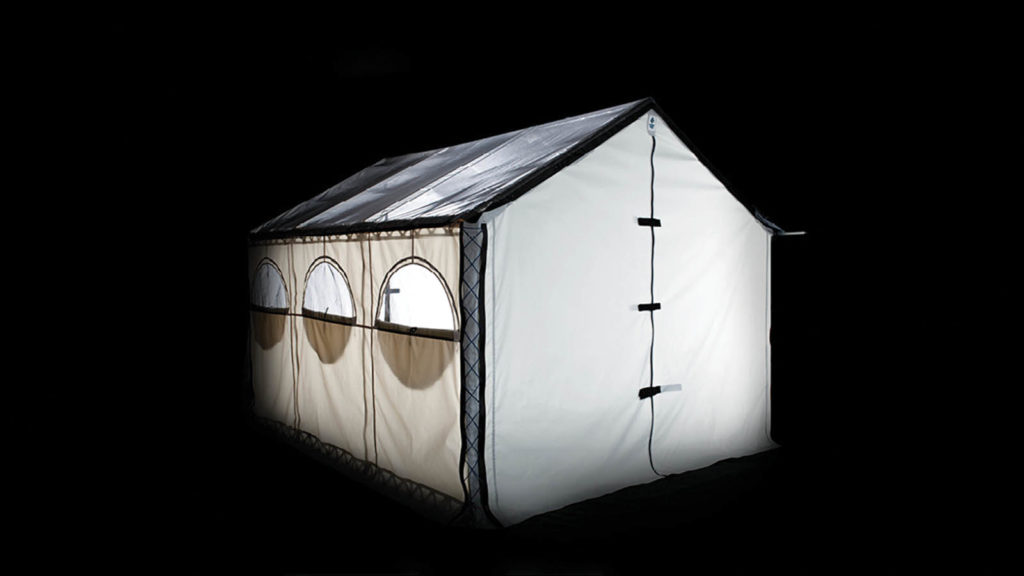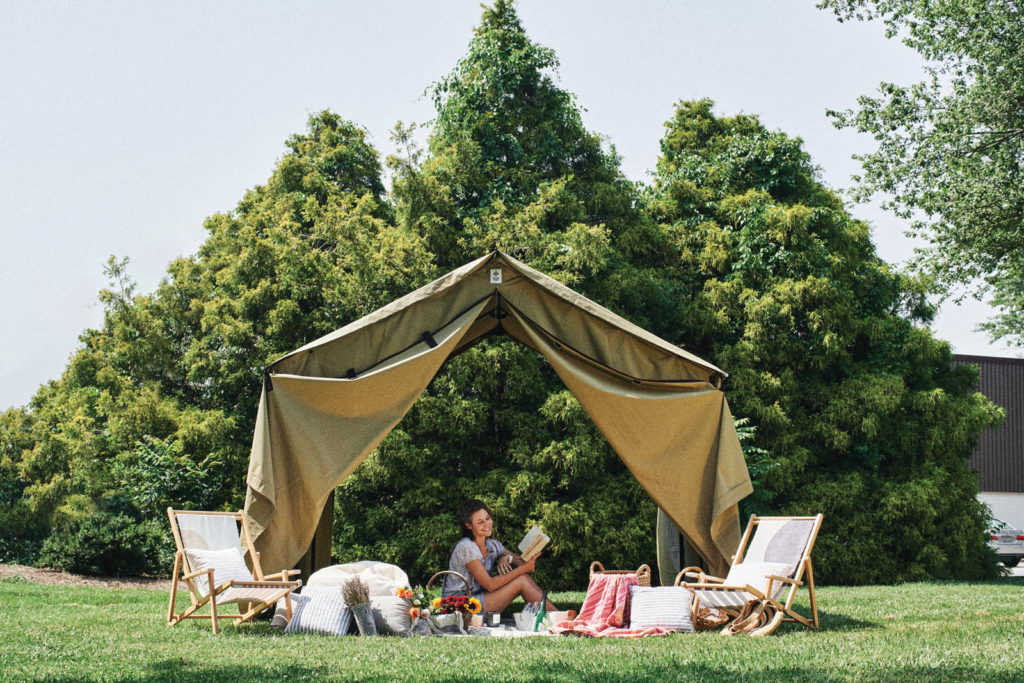
Take an established business with a solid customer base, add a great idea for product expansion and what do you get? The need for capital. Product development takes cash—even when developing the product from the foundation of a thriving business. For Diamond Brand Gear in Fletcher, N.C., developing an innovative modular wall tent meant turning to Kickstarter to launch a campaign. The social media platform designed to bring creative projects to life was unfamiliar territory to Diamond Brand Gear’s CEO John Delaloye—and more than a little work for him and his staff—but as it turns out, it is a strategy that has been well worth the effort.
Spark and substance
The idea for Diamond Brand Gear’s LMNL tent system with its retractable roof, glamping potential and modular components was born of exploring a new way to manufacture wall tents that would be less cumbersome for sewing operators to assemble, according to Delaloye.
“The most difficult part of manufacturing a [wall] tent is the final assembly,” he says. “Right now, the weight and size for the sewing operator to put this type of tent together is huge. Part of sustainable manufacturing includes improving the experience the people working on the tents have—in addition to the impact the tent has on the planet. And what came after that [understanding] was an examination of what user needs might be.”

The resulting vision for the product included portability (the entire system can fit into the trunk of a car) and user-friendly assembly. Materials focused on durability and sustainability, incorporating easily replaceable components, from a click-together frame with 3D-printed connection points to interchangeable panels with inner screens and outer fabrics. Diamond Brand Gear pitched its idea to investors using the Kickstarter platform, looking for a way to meet several goals.
“We were looking to reach some different markets,” Delaloye says. “Over the last 40 to 50 years , we transitioned from an outdoor brand to a contract manufacturer and wanted to reconnect with consumer markets with this product. We thought it might be a good way to reach some individual consumers in a new way.”
Easy, breezy and modular
Among the user-friendly components of the system is that it can be easily assembled by one person. “With the LMNL tent I can do it by myself,” says Lauren Rash, chief operating officer. “And I’m a pretty independent person so being able to throw a frame in the back of my car, set it up and snap on the panels that I want for the weather that day … is the most exciting thing.”
After the tent is set up, its full-screen system allows users to enjoy an outdoor experience with bug protection. “Users can enjoy 360 degrees of breeze and visibility with a full-screen system covering roof and walls—allowing those views of the night sky to also be bug-free,” Delaloye says. “The retractable roof also provides much-needed ventilation, detaching from the walls to allow hot air to escape and cooler air to circulate in, maximizing the time users can enjoy their tent, even during hot days.”

By doing things modularly, the system allows for using more than one material in its production. The roof can be made of one material, potentially synthetic for UV and water resistance, while the walls can be more breathable. “We’re wrapping up a fabric study now that we’re doing with Caroline Cockerham from Wilmington, N.C.,” Delaloye says. “She’s looking at how we might be able to use more sustainable fabrics and how we might redesign the tent to take advantage of some of those. We could potentially use 100 percent recycled polyester for the roof paired alongside organic cotton or hemp on the walls* because we don’t have to look for a one-size-fits-all solution. We’re using things we’ve liked in the past but in different combinations.” (*Fabric components are yet to be finalized.)
Crowdsource connection
Funding the project through Kickstarter allowed Diamond Brand Gear a platform from which it could connect with enthusiastic end users—to garner their investment dollars as well as feedback. A limited number of early backers received free updates to the tent system, for both frame and fabric components. And supporters received certain rewards with exclusive benefits, based on the amount of their investment. Reward levels allowed supporters to contribute an amount that secured various perks from a swag bag up to a set of five tents. All project backers were also invited to the LMNL launch party in Asheville, N.C.
“The immediate benefit was that [Kickstarter] puts you in direct contact with customers,” Delaloye says. “We have 79 backers from a lot of different locations, including some in Canada, which was great because one of our goals was to connect with the Canadian market.”
Internal effort
As a part of the campaign, Diamond Brand Gear’s staff worked together to produce a video, showcasing the internal dedication and collaboration behind the effort. “The LMNL tent has been a labor of love three years in the making,” Rash says. “We are tent makers through and through. Making canvas tents is challenging. By the time it gets to the end of the line, you may have a 75-pound canvas that you’re trying to move through—and that is almost too much for one person.”
For Delaloye and his team, the spark for the process came from asking themselves: Is that the best way to make tents? Delaloye hired a contract mechanical engineer to help develop the tent, who has since come on board as a Diamond Brand Gear employee. “Once I’ve done some development, I go talk to John about it and he has already thought about the approach that I’m working on, and he’s thought up the next one or two steps,” says Andrew Hooker, mechanical engineer. “That relationship, I think, has been key to making this happen.”

The effort has been—and still is—a group effort that began with a dedicated and cohesive Diamond Brand Gear staff. “Seeing the tent hanging on the frame has been an incredible accomplishment,” says Lisa Brill, R&D director, who was tasked with taking the traditional tent apart (among many other things) as a first step in envisioning the new product.
Diamond Brand Gear’s LMNL Kickstarter campaign went live on July 27, 2021, and was fully funded on August 24, 2021; the company expects to have its first tents out the door before the end of the year, depending on supply chain challenges. “One thing we were excited about during this process was sharing our story and the story of this tent,” Delaloye says. “I think Kickstarter is a good place to tell your story. It was a lot of work for the whole team and involved all aspects of tent design, production and fulfillment, but it was worth it. Without a doubt.”
Sigrid Tornquist is a writer and editor in Minneapolis, Minn.
SIDEBAR: Repurpose to the rescue
Diamond Brand Gear’s Tent Rescue Program runs on a swing shift—after the regular crew leaves at 2:30 p.m. each day. The crew works on creative projects that reuse scraps from the company’s production, as well as retired tents from places such as summer camps. The crew makes items including messenger bags and gives half of the proceeds back to the tent’s owner while keeping the other half to sell and recoup costs. “Our goal with the program is sustainability as well as bringing people into sewing who want to sew but don’t necessarily want to do production sewing,” Delaloye says. “We named the concept American Boro, to celebrate Japanese Boro—a way to value, mend and repair with used and scrap fabric. It’s a celebration of a great sensibility and tradition of what’s come before.”
 TEXTILES.ORG
TEXTILES.ORG


